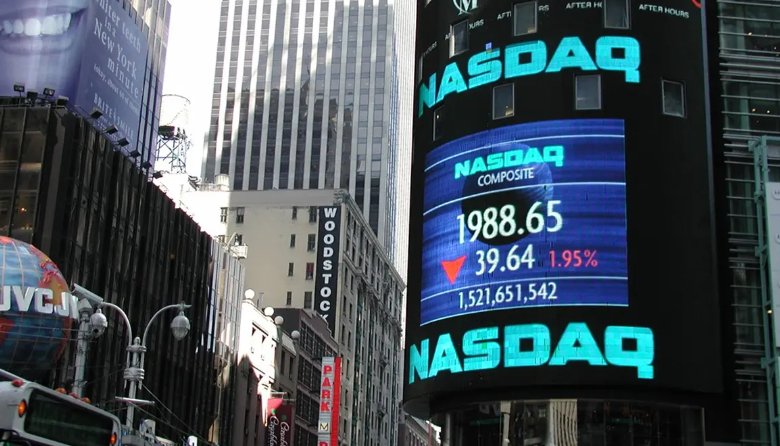What is the Nasdaq? Understanding its history, function, and how it works

The Nasdaq, which stands for “National Association of Securities Dealers Automated Quotations,” is the world’s oldest and largest digital stock exchange, this simply means it does all of its buying and selling online instead of on common traditional trading done physically. And is also the world’s second-largest stock exchange in the financial market by market capitalization, just right after New York Stock Exchange (NYSE) as the first.
When Nasdaq first opened for business in 1971, it’s was a pioneer in online operations, providing a listing service for businesses that had a tracked record of been traded over-the-counter (OTC) before. Many fresh and creative high-tech firms, like Apple and Microsoft, rapidly established themselves there.
With its two primary indexes – the Nasdaq 100 and the Nasdaq Composite– highly followed business barometers, the Nasdaq now plays a significant role in the global economy and most importantly in the US.
In this article, we will discuss everything you need to know about the Nasdaq. So, just take a glass of water, relax and read up to the end.
Contents
WHAT IS THE NASDAQ STOCK EXCHANGE?
Nasdaq is not like an auction market (such as the NYSE), where traders (buyers and sellers) trade with one another via a broker, the Nasdaq is officially a dealer marketplace where traders (sellers and buyers) trade with a market maker in a specific security or stocks.
Some quick facts about Nasdaq:
What does Nasdaq stand for? It simply stands for “National Association of Securities Dealers Automated Quotations,”
On Nasdaq, about 4.5 billion shares are exchanged every day.
Nasdaq has 3,889 businesses listed.
The listed firms on Nasdaq have valued a total of $11.23 trillion.
Business organizations spend $45,000 to $172,000 in charges to be listed on Nasdaq.
The 3,889 Nasdaq-listed firms comprise ten main industry categories. The majority of them work in health care, technology, or consumer services.
While the Nasdaq includes lots of big companies like Apple, Amazon, and Coca-Cola, its equities are more growth-oriented and far less blue-chip more than those on the New York Stock Exchange. Nasdaq stocks are known for volatility and innovation.
THE NASDAQ HISTORY.
The Nasdaq was founded by the National Association of Securities Dealers (Now refer to as FINRA) in the year 1971. It originated as a quote system, that it’s, a digital ticker displaying buy and sell prices – before expanding to include transaction and trading services.
Nasdaq became a completely autonomous, and publicly listed corporation in the year 2002.
It was designated as a national securities exchange by the Securities and Exchange Commission (SEC) in the year 2006.
The Nasdaq OMX group was formed around the year 2007 when it merged with the Scandinavian exchange group OMX.
The Nasdaq does not have a physical trading floor and has never had one. In 1995, when large businesses like Microsoft threatened to depart, this created an issue for the exchange. There was no physical location, no opening bell ceremony, and, most crucially, no area for media channels to transmit from during the trading day since there was no physical trading floor.
That difficulty was remedied in 2000 when MarketSite, a large 10-story tall tower with TV displays, a major broadcasting studio, and, yes, an opening bell ceremony, was built on the corner of Broadway and W 43rd St, New York, NY 10036, USA. The actual trade, however, continues to be done electronically.
It’s a bit odd that Nasdaq, which started as an all-digital exchange, needed to establish a physical presence on Wall Street to earn respect. However, the NYSE and other older, well-known exchanges ultimately realized that they needed a digital presence to stay relevant and competitive in a fast-changing market.
CRITERIA FOR NASDAQ LISTING
Every stock exchange has its own set of regulations regarding which firms are allowed to list and trade on it. Companies must be licensed by the Securities and Exchange Commission (SEC) in the United States, as well as fulfill other exchange criteria, such as financial thresholds.
Nasdaq is divided into three levels, each with its own set of requirements. However, in general, businesses must:
Follow all financial, liquidity, and company management regulations and enroll with the Securities and Exchange Commission (SEC).
Must have a minimum of three market makers ready and willing to help you purchase and sell your stock; most Nasdaq stocks on the of average fourteen market makers.
Furthermore, businesses may soon be required to employ a minimum of one female and also someone who is neither White nor heterosexual.
The key characteristics and requirements for each of Nasdaq’s three levels. Try reading Nasdaq’s guide for further information because each provides a number of ways to fulfill each set of requirements.
Nasdaq Global Select Market Criteria:
The Nasdaq Global Select Market has the most stringent starting liquidity and financial criteria. Being a member of the Nasdaq Global Select Market is a sign of a company’s global standing due to the stringent requirements for inclusion in this tier. Companies must fulfill earnings, asset, or capitalization standards, as well as having nothing less than 1,250,000 publicly traded shares as well as a share price of at least 4dollar.
Nasdaq Global Market Criteria:
The Nasdaq Global Market’s companies have a global presence with the services they offer or products. The Global Market’s criteria are more strict than those of the Nasdaq Capital Market, but not that rigorous when compared to those of the Global Select Market. With few exclusions, Nasdaq Global Market businesses must fulfill equity, market value, total assets/revenue, or income criteria, and must have minimum1,100,000 publicly listed shares, and trade for a minimum of 4dollar.
Nasdaq Capital Market Criteria:
Businesses on the Nasdaq Capital Market are designed to raise capital and, as a result, are usually younger and have less liquidity and income than other businesses. With some exclusions, they must fulfill equity, market value, or net income requirements, have a minimum of 1,000,000 publicly listed shares, and trade for nothing less than 4dollar.
NASDAQ TRADING HOURS
What time does Nasdaq open? The Nasdaq Stock Market opens on Monday to Friday and closed on the weekends. The opening bell sounds at 9:30 a.m. Eastern standard time, which is the Nasdaq opening time, marking the start of trading.
What time does Nasdaq close? The normal session lasts for 6 and 1/2 hours and ends at 4 p.m. Eastern standard time when the closing bell sounds.
The Nasdaq, on the other hand, allows traders to engage in special trading sessions before and after the normal session. These special trading sessions run daily within the weekdays between 4 a.m to 9:30 a.m. Eastern standard time. And, after-market special trading hours begin at 4 p.m. and end at 8 p.m. Eastern standard time. Each year, the Nasdaq closes during some nationally observed holidays.
The Nasdaq Stock Market is known to be the world’s second-largest stock exchange, and it is crucial in the integration of technology into the trading system. Businesses who wish to list their stocks on a US-based stock market might consider using the Nasdaq as an alternative instead of the New York Stock Exchange. The Nasdaq, with its long history of development and innovation, should continue to assist investors for many years to come.
THE DIFFERENCES BETWEEN NASDAQ AND NYSE
Most times when people are thinking about the stock market, the NYSE is likely the first thing that comes to their mind. The New York Stock Exchange (NYSE) is the world’s largest stock exchange, with over 70 of the world’s top businesses as well as numerous household brands like Coca-Cola, Walmart, and McDonald’s
In terms of market capitalization, which is the total dollar worth of all the shares of businesses trading on it multiplied by the number of outstanding shares. The Nasdaq is the second biggest exchange after the NYSE. And aside from market capitalization, the exchanges are distinguished by their areas of specialization.
Nasdaq is recognized as the center of technology and innovation, with firms in the biotech and internet sector, as well as others on the leading edge. On the other hand, the NYSE is home to numerous blue chips, such as financials, industrials, and family-owned businesses.
There are a few more significant distinctions between the Nasdaq and the NYSE to be aware of:
The NYSE has been established for hundreds of years, but the Nasdaq started its operation in the year 1971.
The New York Stock Exchange (NYSE) is an auction market where investors purchase and sell to one other. While Nasdaq is a dealer market, which means that all transactions are conducted via a broker.
The Nasdaq listing costs are cheaper than that of the NYSE, with the lowest Capital Market tier that ranges between $55,000 to $80,000. The cheapest first listing cost on the NYSE, on the other hand, is around $150,000. This may have an impact on where firms choose to list and trade their stock.
Because the NYSE is made up of well-known companies, it has historically been regarded as less volatile than the Nasdaq based on people’s perspectives. Nasdaq, on the other hand, is made up of technology companies and start-ups, therefore some investors consider companies listed on its to be riskier investments.
WHAT IS THE NASDAQ INDEX, AND HOW DOES IT WORK?
Most times when the news channels and media mention the Nasdaq, they are usually referring to what we know as a market index instead of the stock exchange itself.
A market index measures the performance of a select set of companies that represent a certain sector or market segment. The Nasdaq Composite Index, or simply the Nasdaq, is one of the most popular and extensively used indexes for describing entire stock market performance.
Nasdaq is a massive index that includes around 3,000 major companies traded on the exchange. While the Dow Jones Industrial Average (DJIA), on the other hand, is a prominent stock market index that monitors only 30 firms. The S&P 500, in the center, measures the performance of the 500 largest firms in the United States, as its name indicates.
Technology firms like Microsoft (MSFT), Apple (AAPL), Tesla (TSLA), and Amazon (AMZN) make up the majority of the Nasdaq Composite Index. The Nasdaq, on the other hand, also includes firms in the energy, industrial, consumer products, and healthcare areas.
However, we still have other Nasdaq Index asides from Nasdaq Composite Index. For example, the Nasdaq 100 index monitors 100 of Nasdaq’s biggest and most frequently traded securities in the market.
THERE ARE TWO PRIMARY NASDAQ INDICES.
Nasdaq is much more than a stock exchange. It also features two well-known indices that measure Nasdaq stock performance daily:
- The Nasdaq Composite index report covers 2,790 Nasdaq securities, which includes everything except mutual funds, preferred stocks, and derivatives. The Nasdaq is strongly loaded with technology companies’ stocks making it the industry’s ‘de facto’ barometer.
- The relatively small Nasdaq 100 index concentrates on the Nasdaq’s largest non-financial firms. Over half of them operate in the IT industry.
The Nasdaq Composite is the most significant of the two. When pundits say “the Nasdaq closing up five points,” they’re generally referring to the Composite.
The Nasdaq 100 is watched by investors and traders who are more interested in options, exchange-traded funds, and futures. Whereas the Composite index is more generally followed.
HOW THE DAILY AVERAGE OF THE NASDAQ INDICES IS CALCULATED
The Nasdaq Composite and Nasdaq 100 both utilize the same customized market capitalization weighting technique, which calculates a stock’s market capitalization simply by multiplying the closing price value of each of the shares (LSP) and the total shares outstanding (TSO) for that firm altogether.
The market capitalization of each security is divided by the total capitalization of the overall index securities to determine the share weights. The closing price value of each stock is multiplied by the share weights, and the result is then divided by an index divisor that accounts for market movements like mergers, stock splits, and other activities. The Nasdaq average for that day is the outcome.
THE NASDAQ INDICES’ PERFORMANCE
Nasdaq stocks price led the pull in the United States’ longest bull run market in the 2010s. Its indexes outpaced the S&P 500 (that monitors large-cap firms) as well as the Dow Jones Industrial Index (that monitors the top 30 US businesses), along with two other stock market benchmarks.
The explanation?
Both Nasdaq indexes are strongly weighted in technology, consumer services, and health care, which have all outperformed in recent years.
WHAT IS THE BEST WAY TO INVEST IN NASDAQ STOCKS?
With an individual stock investment, you may always try to replicate the Nasdaq 100 or Nasdaq Composite. However, investing in an index fund that monitors the market’s indexes is likely to be more productive. most of them trade on Nasdaq naturally
The Invesco Unit Investment Trust QQQ ETF ( QQQ ), which follows the Nasdaq 100, is one of the most prominent Nasdaq index funds.
Fidelity’s Nasdaq Composite Index ETF ( ONEQ ) is a notable exchange-traded fund for investing in the whole Nasdaq composite.
If you’re thinking of investing in a mutual fund, then the Fidelity Nasdaq Composite Index Fund ( FNCMX ) is a well-known option.
The Nasdaq is a public corporation that you may invest in asides from being a stock market. Nasdaq Inc. is the company’s stock symbol. But keep in mind that you’re investing in the firm itself, not really the stocks it trades on the stock exchange.
FINAL THOUGHTS:
The Nasdaq was the first digital stock exchange, and it created history. The stock exchange, which is now the world’s second-largest major stock exchange, represents market activity in the technology and developed firms. Those who invest in these sorts of securities keep a close eye on the Nasdaq as well as its indexes.
However, it’s always good to understand that there is a higher risk attached to investing in Nasdaq’s stock or Nasdaq’s is due to its volatility than investing in the DJIA or NYSE, which both rely on less volatile and more established firms. However, this might result in larger profits.
Nasdaq indices, which are heavily weighted toward well-developed firms, have outpaced others. The ETFs or Nasdaq-tracking InvesNasdaq-tracking mutual funds investment is an efficient and simple method for investors to benefit with minimal risk.
Table of contents
- WHAT IS THE NASDAQ STOCK EXCHANGE?
- THE NASDAQ HISTORY.
- CRITERIA FOR NASDAQ LISTING
- NASDAQ TRADING HOURS
- THE DIFFERENCES BETWEEN NASDAQ AND NYSE
- WHAT IS THE NASDAQ INDEX, AND HOW DOES IT WORK?
- THERE ARE TWO PRIMARY NASDAQ INDICES.
- HOW THE DAILY AVERAGE OF THE NASDAQ INDICES IS CALCULATED
- THE NASDAQ INDICES’ PERFORMANCE
- WHAT IS THE BEST WAY TO INVEST IN NASDAQ STOCKS?
- FINAL THOUGHTS:




